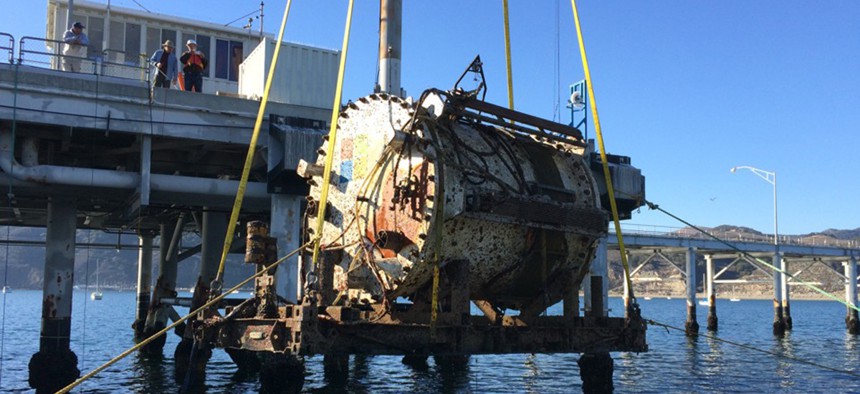Microsoft's Project Natik Test-Drives a Data Center Under the Sea

Microsoft
The cold water of the deep sea may be an ideal environment for server farms.
For all the ethereal imagery, the cloud is a highly physical, earthbound thing.
When people check their Facebook likes or stream Netflix, the computing activity happens somewhere, usually somewhere far away in a gigantic warehouse stacked with high-powered computers. Those data farms aren’t floating in the sky. They’re sitting on land, sucking up a ton of energy and water for running and cooling the machines. They also tend to be built where land is cheap and millions of gallons of water won’t be missed—in other words, far from the dense urban communities that house most web users.
But Microsoft recently discovered another location that fits that description: the bottom of the ocean.
Project Natick submerged a 38,000-pound, 10-by-7-foot steel tube off the coast of California for three months to see if the servers inside it continued to function with the power of 300 desktop PCs. The company says this is the first time a data center has operated under the sea. And it worked. That achievement opens the door for future data-storage infrastructure to take advantage of the natural cooling properties and renewable energy of the underwater location.
Since ocean water gets pretty cold toward the sea floor, the server farms won’t need the kind of intense cooling infrastructure that’s vital to avoiding costly meltdowns on land. And the researchers plan to hook up their next underwater capsule with technology to capture the motion of the waves as hydrokinetic energy.
There’s another potential benefit for anyone who uses modern digital devices in cities. Data centers tend to crop up far from the urban populations that make the most use of them, as cloud-service companies try to save money on operating expenses. But those remote locations also create a problem with latency—the services move more slowly when the data has to travel farther. Since many of the world’s busiest cities sit on coastlines, underwater data storage could get a lot closer to the action than the traditional landlocked alternative.
Project Natick’s approach to cloud storage also gains efficiency by standardizing the manufacturing process. Normally, server farms have to be built to meet site-specific permitting issues and construction costs. It’s hard to streamline those obstacles from project to project. But the researchers built the undersea unit in 90 days, illustrating the potential time-savings of water-bound modular fabrication.
They’ll still need to study the environmental effects of large-scale underwater data-storage deployment. The Microsoft engineers found that the clicking of the local shrimp population overwhelmed any noise the computer tube was making, and that heat output was only detectable within a few inches of the capsule, The New York Times reported. No doubt those impacts will increase as the computing power scales up, and will have to be addressed in the design process.
On balance, though, this technology looks good for the environment: less water usage and energy needed from the grid, and a decrease in the acres of landscape devoted to our computing needs.





